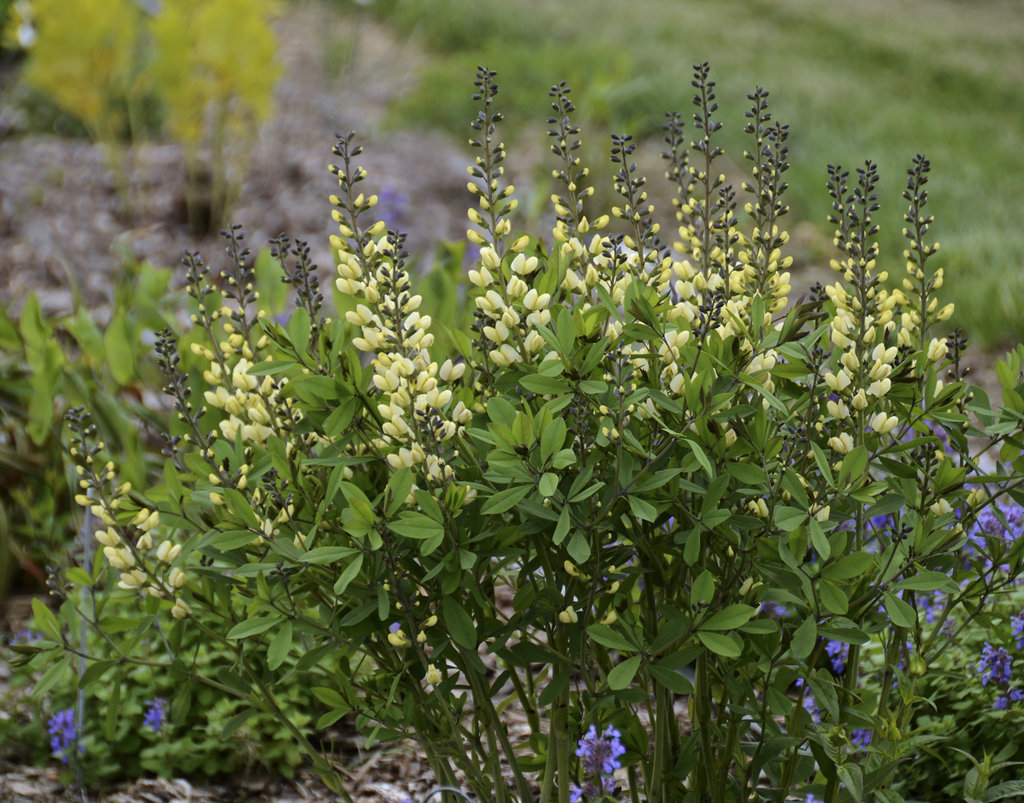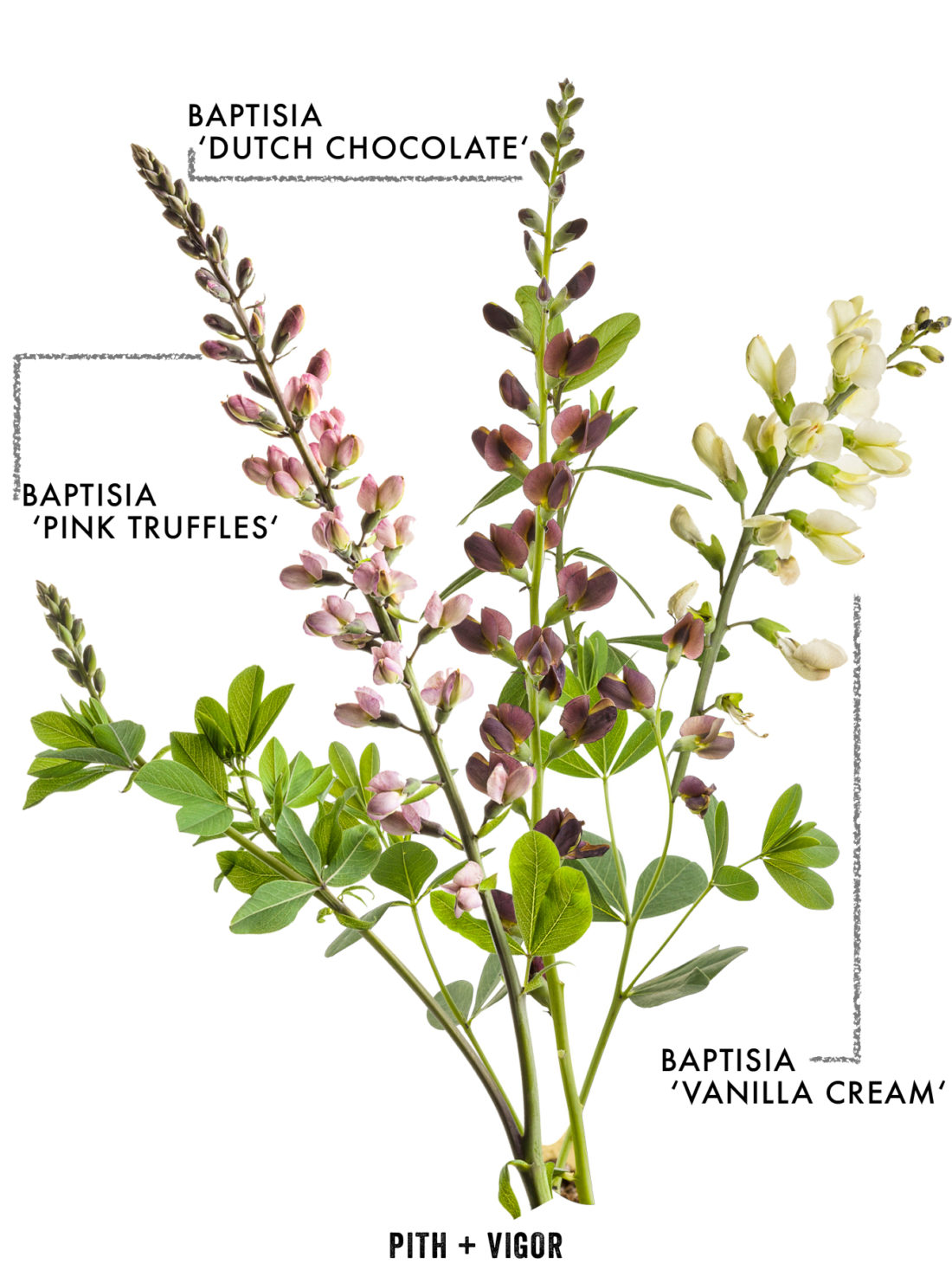Years ago, when the Perennial Plant Association named Baptisia australis (also known as wild false indigo) their plant of the year (in 2010), I promptly bought five and planted them in my garden. They were new to me at the time, and they were lauded for being low-maintenance and long lived. Perfect.
Then, the next spring, I accidentally weeded out every single one of them.
It is hard to recover from gardening disasters like that. I didn’t even realize my mistake until months later when I wondered where my ‘new’ plants were.
The sting of lost money, the holes that should have been filled. And I really wanted that blue color. Ouch. I am still cursing myself. But gardening isn’t a sport for the weak-spirited. After many baptisia-free years, I’ve licked my wounds enough, and I am finally ready to try again.
The many colors of Baptisia.
I’m particularly inspired by the newer colors of baptisia. While I still want that blue, I am more seduced by the wine color of Baptisia ‘Dutch Chocolate’, the soft pink of Baptisia ‘Pink Truffles’, and the dark buds of Baptisia ‘Vanilla Cream’ that open to creamy white flowers.
Buy your favorite>>>
- Baptisia australis is the classic blue color.
- B. Blueberry – a darker purple variety.
- B. Decadence ‘Pink Truffles’ – Flowers are lavender pink.
- If you want white flowers, grow Baptisia ‘alba’.
- Lemon Meringue Baptisia has soft yellow blooms.
- Dark Chocolate Baptisia.
Maybe it is a blessing. Had those original plants lived, they would be huge by now. And I’m sure I wouldn’t remove them to make space for something fresher and more exciting. This is how you have to think in this gardening game: every failure happens for a reason; always look at the bright side.

False indigo Vs. Actual Indigo
As a complete aside – I am always intrigued by plants that are ‘false’ or something else. Baptisia is ‘false’ indigo. When I compare the plants, they look so similar that I wonder what makes them horticulturally different (I don’t claim to know).
Native Americans and settlers used Blue false indigo (Baptisia australis) and yellow wild indigo (Baptisia tinctoria) to produce a blue dye before the introduction of the better quality true indigo (Indigofera tinctoria).
True indigo has fascinated me for a while. Have you read the book Someone Knows My Name by Lawrence Hill? It is a great read, but there is one detail that sticks in my mind years later. Plantation slaves who processed indigo around Charleston, SC, had to collect and use their own stale urine to extract the dye. Lawrence Hill describes the process in the novel, and it isn’t pretty. After reading it, I had to fact-check and learn more.
Of course, truth is sometimes worse than fiction – you can’t make this stuff up. This was part of the brutal, horrible, disgusting, smelly process. I haven’t researched what goes into modern processing of indigo… but I hope and assume it doesn’t involve human pee.

Companion Plants: What to plant with Baptisia Australis – Design Ideas for Wild False Indigo:
These are some of my favorite companion plant ideas for wild false indigo.
- Plant alongside another plant that turns bright colors in the fall. The orange and yellow fall colors of dwarf fothergilla (fothergilla gardenii) and the black of blue false indigo (Baptisia australis) are dramatic. The black Baptisia foliage would be a striking partner to anything that goes red, orange, or yellow.
- Tony Avent of Plant Delight Nursery recommends planting baptisia to highlight their shape.”I like to use Baptisia as a specimen plant where their structural form can be appreciated. To do this, they should be underplanted with ground covers that highlight their best attributes. Some of my favorite subservient plants for Baptisia include Artemisia ‘Powis Castle’, Veronica ‘Sunshine’, V. ‘Aztec Gold’, or V. ‘Georgia Blue’. I like to play yellow against blue. Choose your color of groundcover according to your choice of Baptisia.
- Baptisia makes a good partner for early spring bulbs. As the bulbs fade late in the spring, the foliage of the Baptisia will grow in and will distract and obscure the fading foliage.
More about Baptisia australis:
About Baptisia
Baptisia is prized for being rugged and beautiful. It has spires of blooms that look a little like lupine with stacked-up sweet pea flowers. Bees love it, and its 3-4 ft stature is really eye-catching.
Botanical Name: Baptisia australis and Baptisia cultivars
Common Name: False Indigo, Wild Indigo
Habitat: Tolerant of poor soil and pH. Water well when establishing, but once its root system has developed, additional watering is generally not needed.
Seasonal Interest: Baptisia blooms in Spring/ summer. The foliage turns dark brown or black in the winter, and the plants retain their decorative seed pods.
Aspect: Full Sun, Tolerate partial shade, but can get lanky if too shaded.
Maintenance: After booming, the spikes can be trimmed off, leaving sturdy, attractive foliage that looks like a rounded shrub. Pruning can stimulate new growth. They die back to the ground with the first frost but will return bigger and better in subsequent years. (so long as you don’t weed them out)
Problems and Diseases: Pest and disease-resistant; however, voles may eat roots.
Growing and Designing with Wild False Indigo – FAQ
Give Baptisia lots of room in the full sun. Each plant will take up 2-4 feet in all directions and will be a big statement in your garden beds. It is best suited for the middle or back of a planting area.
Baptisia has deep tap roots and will spread underground. It is a sizable plant, and due to the root spreading, it will get bigger every year. It is not, however, invasive, but it can be hard to remove if you want to transplant it.
Baptisia will die back in the winter due to frost, but you don’t have to cut it back. This is a plant that has a lot of winter interest with great seed pods and sturdy stems that go to an inky black color. It looks great in a winter landscape, so consider waiting to cut it back until late in the winter or after it has started to lose its winter interest from snow cover or wind damage.
Baptisia is a sun-loving plant and needs at least 6 hours of direct sun per day. If it does not get enough sun, it will get leggy, it will flop, and it will not bloom as well.
What is your experience with Baptisia? How does it grow for you? What have you planted it with that was beautiful?
images: Proven Winners Distant Hill Gardens

This is an amazing plant and I put it in many full sun gardens. It has great foliage, wonderful flowers and fabulous seed pods making it a plant that pays its dues in the garden. Not to mention that it is native!
I love this plant, from the first moment I saw it growing at Cotswold Garden Flowers, with Bob Brown I have been smitten.
Its so useful it complements so many plants or acts a show stopper itself. At the nursery I co-own we have it growing in our stock beds with Anthemis and Phaenosperma, even when not in flower the leaf texture, shape and colours all work fantastically well together. What are you going to grow it with, thats going to be the question!
Baptisia is quite nice — they are like lupines but not as picky — taking just about any kind of conditions you can throw at them. The flowers are nice, and the leaves are quite attractive as well. One comment: They tend to be a little bare at the bottom of the plant, so they look good with something in front of them to cover up the undressed legs.
I love baptisia! My purple baptisia looks great next to my William Baffin climbing rose in bloom. The only downfall is that they only bloom for about 1 1/2 to 2 weeks early spring, like the peony. But like the others have said, it has great foliage and the seed pods are interesting. The seed pods turn black and in the wind, they sound like rattlesnakes. I just bought a Screamin’ Yellow one last spring. I’m hoping to get my hands on a burgundy one – Twilight Prairieblues this spring. Once planted, they do not like to be moved. Their size is like a peony – 3′ – 4′ round mound. I have sedum planted at the base of my purple baptisia.
I planted a Baptista appoximately 40 years ago and it is beautiful and doing very well.
We love our baptista; gorgeous color, unusual and lovely leaves…it grows like hosta, circularly…and we share the pods for seeds with other gardeners. You can never be sorry you found, or bought, or got…a baptista. Wonderful. Just brought in leaves to enhance another fall bouquet.
In spring we used the deep indigo blooms for centerpieces at a bridal shower. Wonderful response. So pretty and again, unusual looking, smells great.
Loving a plant, great part of life